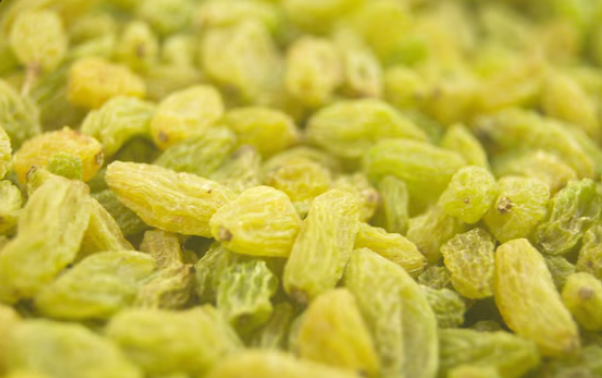Chlorophyll Retention in Green Long Raisins Depends on Shade Drying and Sulfur Levels
Maintaining the bright green color of long raisins is a significant challenge for growers and exporters. This color is primarily due to chlorophyll, a natural pigment sensitive to drying conditions and chemical treatments. Understanding how shade drying combined with proper sulfur dioxide levels helps retain chlorophyll can lead to better-quality raisins that stand out in competitive markets.
Why does chlorophyll retention matter so much?
Green raisins are valued not only for their visual appeal but also for their nutritional qualities. When chlorophyll degrades, raisins turn brownish, reducing their market value and perceived freshness. This often happens during the drying phase, especially under direct sunlight. What if there were a method to minimize this loss while keeping drying efficient and cost-effective?
our product: long green raisins
How Chlorophyll Breaks Down During Drying
Chlorophyll is prone to oxidation when exposed to light, heat, and air. Sun drying exposes grapes to high temperatures and UV radiation, accelerating pigment breakdown. This results in a dull, less desirable color. Conversely, shade drying reduces direct light exposure and heat, slowing the oxidation process. However, shade drying alone cannot fully prevent color loss due to other biochemical reactions.

Why Shade Drying Is Essential for Green Raisins
Shade drying creates a cooler, controlled environment that preserves chlorophyll better than traditional sun drying. Studies show that raisins dried under shade retain a higher percentage of their green pigment. This method also decreases physical damage and reduces moisture stress, which otherwise promotes enzymatic browning. For producers, adopting shade drying may initially require adjustments, but the improvements in raisin quality and export appeal justify the effort.
The Crucial Role of Sulfur Dioxide in Preservation
Sulfur dioxide (SO₂) is widely used as a preservative in dried fruits. In raisin drying, it acts as an antioxidant, inhibiting enzymatic and non-enzymatic browning that destroys chlorophyll. The concentration and timing of sulfur application are critical. Excessive sulfur can cause health concerns and affect flavor, while insufficient amounts fail to prevent color loss. Careful monitoring ensures raisins maintain their green hue without compromising safety or taste.
Combining Shade Drying with Controlled Sulfur Levels
Integrating shade drying with optimized sulfur treatments offers the best results. Shade drying reduces physical and photodegradative stress, while sulfur dioxide chemically protects chlorophyll molecules. This dual approach extends shelf life, enhances export quality, and meets international standards. Growers should aim for sulfur levels that balance preservation with regulatory limits to avoid any negative effects.
Practical Guidelines for Producers
- Select appropriate shade materials that allow airflow but block direct sunlight effectively.
- Monitor temperature and humidity in drying areas to maintain optimal conditions.
- Apply sulfur dioxide in measured doses, preferably during early drying stages for maximum effect.
- Use protective gear and follow safety protocols when handling sulfur to ensure worker safety.
- Regularly test raisin color and sulfur residue to comply with export regulations.
read more: The Impact of International Food Exhibitions on Promoting Iranian Green Raisins
Why This Knowledge Matters for Exporters and Buyers
For bulk buyers and importers, understanding drying methods and sulfur levels helps assess raisin quality accurately. Green long raisins processed under shade drying and controlled sulfur conditions retain superior appearance and nutritional benefits. This knowledge supports better purchasing decisions and strengthens supplier relationships.
Frequently Asked Questions about Chlorophyll Retention in Green Long Raisins
What causes chlorophyll loss in raisins?
Exposure to heat, light, and oxygen during drying accelerates chlorophyll degradation.
How does shade drying preserve raisin color?
It limits direct sunlight and reduces temperature, slowing oxidative reactions.
Why is sulfur dioxide used in drying raisins?
SO₂ acts as an antioxidant, preventing browning and preserving color.
Can too much sulfur affect raisin quality?
Yes, excess sulfur can impact taste and may pose health risks.
Are shade drying and sulfur treatment enough to ensure export quality?
Combined, they significantly improve color retention and shelf life, meeting export standards.

